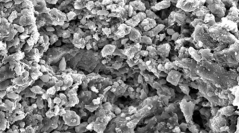

 Comptes Rendus Palevol
6 (8) - Pages 557-568
Comptes Rendus Palevol
6 (8) - Pages 557-568Flint has been widely used during prehistoric times and the question of determining the origin of specific pieces is recurrent in archaeological discussions. We have run a scanning electron microscope examination of the surfaces of both natural flints from geological deposits and flaked artefacts excavated from prehistoric sites in the Massif Central (France). These samples exhibit mineralogical textures resulting from genomorphic and phenomorphic processes, dispersed alteration in the form of erosion as well as the dissolution and migration of more or less mobile elements. Rocks used to manufacture artefacts at Sainte-Anne 1 (Haute-Loire, France) and Payre (Ardèche, France) show various kinds of alteration related to the range of phases of transport and deposition to which they were subjected, beginning with their first exposure in a geological context and following through to the post-depositional phase, (i.e., following abandonment as artefacts in an archaeological site). Later phenomena do not however completely obliterate stigma imprinted prior to their prehistoric collection, because the main late-phase change that occurs on flat surfaces prior to their collection is preserved in the hollows of remnant natural surfaces on archaeological tools. With the scanning electron microscope, five distinct morphologies representative of different environments have been characterised by establishing associations between the different forms and by plotting their regional distribution.
Flint, Neocortex, SEM, Middle Palaeolithic, Gathering outcrop, Haute-Loire, Ardèche, France